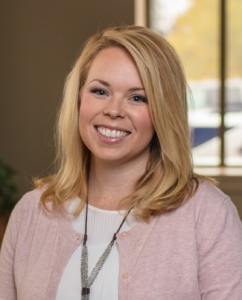By Hannah Flanders
Most people do not grow up dreaming of a career in banking. In fact, many of today’s bankers look back on their paths that led them to the industry as a “happy accident.” However, with large numbers of retirees leaving the workforces every year and evolution caused by technology, regulation, and customer expectations reshaping the industry, banks across Wisconsin are hoping to inspire and cultivate a new generation of aspiring professionals who see the banking industry as an exciting and rewarding career choice.
“We have to build our bankers from the younger generation,” emphasizes Kari Davis, chief talent officer at Lake Ridge Bank in Madison. “Students don’t know what they don’t see; it is our role to demonstrate to them the business of banking and why our teams feel so passionate about their work.”
Starting Young
For Gwen Schnitzler and the team at Forward Bank, Marshfield, introducing banking as a career opportunity to students long before their high school graduation is a priority.
“Interacting with high schoolers is the greatest way to ‘get into the minds’ of local students,” said Schnitzler, vice president – human resources. “As a bank, we want them to know of the opportunities present in our industry. As a community bank, we want them to know these opportunities are available here in their hometown.”
The Wisconsin Department of Workforce Development’s Youth Apprenticeship (YA) program has helped banks across the state connect with high school juniors and seniors exploring different career paths. The program — which features pathways related to finance/banking, marketing, and business administration — combines classroom instruction with on-the-job training.
Through the YA program, banks, including Forward Bank and Lake Ridge Bank, have found great benefit in introducing students to the careers available to them with hands-on experience. Both Davis and Schnitzler note that YA’s defined paths make it easy for banks to facilitate the most relevant and meaningful experience for both the student and the team. So much so that several apprentices who started at either bank went on to study finance, or another banking-related area, in college and later returned to the same institution for full-time employment.
In addition to apprenticeship opportunities, many banks across the state utilize internships to connect with students in both high school and college. While these opportunities may look different depending on the size and location of the bank, one thing is certain — to keep students engaged, it is important that their work allows them to exercise and expand their skillset. Finding unique ways for students to contribute directly to the institution may just be the difference between a résumé builder and the beginning of a fulfilling career.
“Whether they are students working as apprentices or interns, these individuals aren’t focused on filing and scanning. Our goal is to demonstrate the full experience of what it means to be a banker — operating in a professional environment, getting into the community, meeting with clients. . . that’s what they really want to see and experience,” highlights Davis.
To help recruit for open internship opportunities and raise awareness of the banking industry, many banks across Wisconsin also partner with local colleges and universities. As a partner or sponsor, bankers may attend networking events such as career fairs, take part in career readiness events by hosting mock interviews, and collaborate with students, among the many other benefits of establishing the bank as a trusted employer and advocate for student success.
Creating a Meaningful Experience
At Johnson Financial Group, Racine, the 10-week summer internship program concludes with a group presentation to members of the bank’s senior leadership team. Throughout the program, interns work together on a relevant business challenge. The presentation offers interns the chance to present their findings and share feedback with bank leaders.
“More than anything, we want our interns to feel like they are part of the team,” says Logan Aguilar, human resources specialist – early career. “Within the first week, they are keyed in on our current strategic goals, and by the end of the summer, students have had the opportunity to hear directly from our business partners on their paths into the industry, see firsthand our culture and values, and contribute their skills in various areas of the bank.”
Through the internship program at Lake Ridge Bank, students are not only able to develop practical skills for their future careers, but they are also encouraged to join their mentor on an off-site business visit to meet current clients, learn more about their role in the community, and directly hear the role of the bank from a customer perspective.
“Most students are not coming into banking from a career standpoint; they are attracted by the opportunity to make a difference,” says Davis. “Meeting and hearing from our clients is a great way for interns to broadly see this impact.”
Networking with clients, fellow interns, and current bankers helps students to build valuable connections that can be instrumental in their future careers. In addition, offering hands-on experience, taking time to introduce interns to the various functions of a bank, what departments make up the bank, and the broad range of knowledge and skill sets that lend themselves to a successful career in the industry help students envision a future career.
Johnson Financial Group’s Vice President – Talent Acquisition Manager Nikki Redmond notes that because students may not be aware of the myriad career paths available in the industry, they may mistakenly believe that if one option does not align with their interests, there are no alternative avenues available. “The banking industry offers so many opportunities for growth, and people move around; it’s not uncommon to hear of bankers moving throughout the organization to find the area that fits them best.”
For banks, it is important to make this clear when connecting with or employing students.
Conveying the Benefits
There is no doubt that allowing students to gain hands-on experience in a bank setting is the best way to showcase what career opportunities are available in the banking industry. However, human resource professionals in the banking industry agree that it is equally important to emphasize the broader advantages the industry offers.
“Banks offer a certain level of security that students don’t know — or maybe even consider — when they first begin thinking about their future career,” highlights Schnitzler. “Beyond showcasing what opportunities are available throughout the bank, we must be diligent in emphasizing how students will benefit from pursuing these career opportunities.”
From career advancement opportunities to job stability, banking is set apart from many industries with the ability to be both consistent and ever-changing in positive ways. With a rich history spanning nearly two centuries, Wisconsin’s banking industry has long shown commitment to supporting the economic vitality of the state. Yet, in order to meet the evolving needs of Wisconsinites, banks remain adaptive and resilient to changing conditions allowing for bankers to continually explore new avenues to make meaningful contributions. For the younger generation, a career in banking is not only rewarding but long-lasting.
For many bankers of all experience levels, the greatest benefit of their career is related to involvement in the community. Being present at community events, sharing success stories and donations, and volunteering at local organizations and schools is highly rewarding. Similarly, student employees and interns should be encouraged to be active in the community.
For the summer interns at Johnson Financial Group, this means taking part in a community service activity during the internship program’s annual Service Day and participating in the Light the Hoan Intern Challenge.
Reaching Diverse Talent
Throughout Wisconsin, banks provide a diverse range of services that cater to a wide variety of individuals, businesses, and communities. As such, it is critical that bank outreach efforts are just as inclusive and accessible.
In attempting to connect with the younger generation, human resource managers highlight the importance of utilizing the internet, social media in particular, for recruiting. Posting all available job openings, sharing banker/client success stories, and tailoring content to students and young adults helps expand the bank’s reach. Banks that are members of the Wisconsin Bankers Association (WBA) may post internships on WBA’s job board for free, and other job opportunities may be posted for a modest fee. Additionally, thousands of employers, including banks, utilize Handshake — a commonly used recruiting platform for college and university students — to connect with students throughout the state.
Providing opportunities for students to shadow and explore diverse roles within the bank and build early connections in their career journey are pivotal for success. However, human resource professionals agree that the greatest challenge lies in dispelling preconceived notions about the banking industry.
“There is a certain stigma surrounding the banking industry — that you have to be good at math or like numbers, but the reality is that the banking industry is much more diverse and dynamic than students may realize,” notes Redmond.
For banks seeking new opportunities to reach the next generation of talent, the Association has created a ‘Careers in Banking’ brochure to inform students of the banking industry and its benefits as a career. The brochure is free to all members at their request and may be customizable to reflect the opportunities available at a given institution.
By addressing these misconceptions and fostering an inclusive culture that embraces the varied skills and talents individuals bring, we not only break down barriers but also pave the way for an industry that truly reflects the richness of perspectives and abilities within our society.
###
About Forward Bank
Forward Bank is a customer-owned, independent community bank who operates to benefit its depositors while offering no fee deposit options, lower lending fees, and rates. The bank continues to be community-orientated by proudly supporting local clubs, businesses, sports, organizations, and schools.
Forward Bank currently has offices in Athens, Colby, Dorchester, Greenwood, Marshfield, Medford, Park Falls, Phillips, Stanley, Thorp, and Withee. For more information, please visit www.forward.bank.
About Johnson Financial Group
Johnson Financial Group is a privately-owned financial services company offering banking and wealth solutions through its subsidiaries, Johnson Bank and Johnson Wealth. Principal owners of Johnson Financial Group are members of the Samuel C. Johnson family. Helen Johnson-Leipold is Chairman of Johnson Financial Group. For more information visit www.johnsonfinancialgroup.com.
About Lake Ridge Bank
Lake Ridge Bank’s mission is to “create extraordinary banking experiences where everyone prospers.” For more than 100 years, this has meant getting to know each of our clients to offer personalized services to meet their specific financial goals. Lake Ridge Bank offers a full line of financial products and services. We focus on offering products and services to make your banking easy. Our business banking and mortgage lenders are trusted leaders in their field with the expertise to provide the right loan at the best rate possible for our clients. As a community bank, we are dedicated to reinvesting in, and making our communities great places to live, work and raise a family. Visit www.lakeridge.bank to learn more about how we can help you.
 By Daryll Lund
By Daryll Lund


 By Rose Oswald Poels
By Rose Oswald Poels




 Always remember that your employees are your greatest asset
Always remember that your employees are your greatest asset